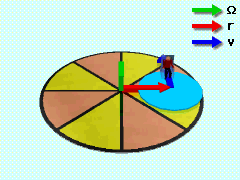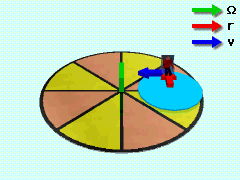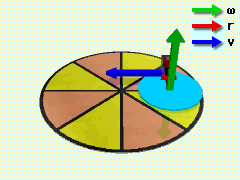| Ch 5. Rigid Body General Motion | Multimedia Engineering Dynamics | ||||||
| Fixed Axis Rotation | Plane Motion Velocities | Zero Velocity Point | Plane Motion Accelerations |
Multiple Gears |
Rot. Coord. Velocities | Rot. Coord. Acceleration | |
| Rotating Coordinates: Velocities | Case Intro | Theory | Case Solution | Example |
| Chapter |
| - Particle - |
| 1. General Motion |
| 2. Force & Accel. |
| 3. Energy |
| 4. Momentum |
| - Rigid Body - |
| 5. General Motion |
| 6. Force & Accel. |
| 7. Energy |
| 8. Momentum |
| 9. 3-D Motion |
| 10. Vibrations |
| Appendix |
| Basic Math |
| Units |
| Basic Dynamics Eqs |
| Sections |
| eBooks |
| Dynamics |
| Fluids |
| Math |
| Mechanics |
| Statics |
| Thermodynamics |
| ©Kurt Gramoll |
|
|
||
|
|
This problem involves two rotating disks, which suggests using two separate coordinate systems. |
|
|
The main disk's angular velocity, Ω, is 1 rad/s about the fixed X-Y axes. The rider disk is attached to the main disk 3 meters from the center and has an angular velocity, ω, of 2 rad/s relative to the main disk. The rotating x-y axes are attached to the main disk and rotate with the main disk. The rider is 1.5 m from the rider-disk center. The question requires the velocity at t = 2.4 s. Since both the time and angular velocities are known, the rotational position of both disks can be determined by θ = Ω t and β = ω t. The final position can be determined with θ and β known. The disks are assumed to be at full speed at Use the relative velocity equation in the I-J fixed coordinate system (the i-j system could also be used): vB = vA + Ω × rB/A + vB/A Analyze each term in the equation. |
|
| Term vA (motion of A about center
pt. O) |
||
 Velocity of A |
The first and simplest term is vA. vA = Ω × rA/O = 1K × 3(cosθI + sinθ J) = 3(cos(Ωt) (K×I) + 3(sin(Ωt) (K×J) = -3 sin(1(2.4)) I + 3 cos(1(2.4)) J = -2.03 I - 2.21J Notice that all the vectors can be described in the rotating i-j or the non-rotating I-J coordinate system. However, do not mix coordinate systems. |
|
| Term Ω×rB/A (motion of B, rotating axis) |
||
 Velocity of B Due to Rotation |
Next, look at the rotating axis term. It is important to note that the total rotated angle for the position vector, rB/A is θ + β. Ω × rB/A = 1K × 1.5 (-sin(θ+β)I + cos(θ+β)J) = -1.5 sin(Ωt+ωt) (K×I) + 1.5 cos(Ωt+ωt)(K×J)) = -1.5 cos(3(2.4))I - 1.5 sin(3(2.4)) J = -0.912I - 1.190J m/s |
|
| Term vB/A (motion of B with respect
to A) |
||
 Velocity of B with Respect to A |
vB/A = ω × rB/A = 2K × 1.5(-sin(θ+β)I + cos(θ+β)J) = -3 sin(3t) (K×I) + 3 cos(3t) (K×J)) = -3 cos(3 (2.4)) I - 3 sin(3 (2.4)) J = -1.82 I - 2.38 J |
|
| All Terms |
||
 Theory vs. Numerical Results |
Now, putting all three terms together gives vB = (-2.03 - 0.912 -1.82)I + (-2.12 - 1.19 -2.38)J vB = -4.76I - 5.78J The maximum occurs at about 2.4 seconds and will repeat the maximum velocity every 3 seconds. This rapid repeating of the maximum velocity makes the ride exciting. However, the maximum acceleration also needs to be be investigated to insure the ride is safe. This done in the next section. |
|
